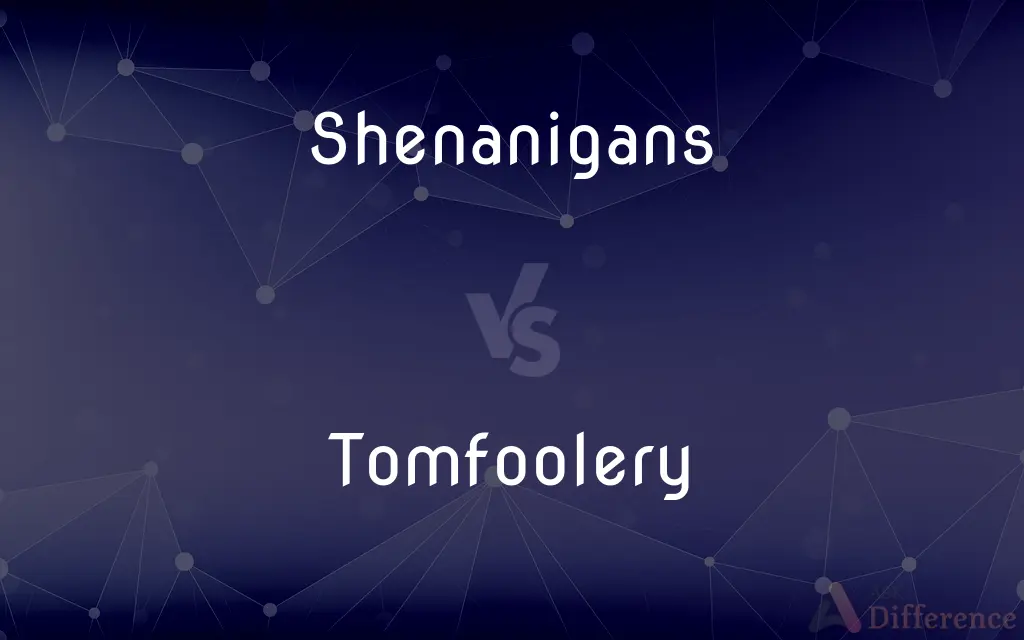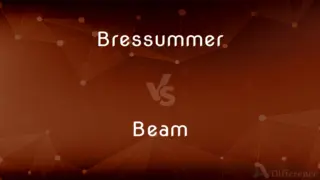Shenanigans vs. Tomfoolery — What's the Difference?
By Fiza Rafique & Urooj Arif — Updated on April 1, 2024
Shenanigans are deceitful or mischievous activities, often implying trickery or manipulation, while tomfoolery refers to foolish or silly behavior without any serious intent or harm.

Difference Between Shenanigans and Tomfoolery
Table of Contents
ADVERTISEMENT
Key Differences
Shenanigans are activities that involve deceit, trickery, or mischief with a potential for causing annoyance or trouble. They often carry a connotation of underhandedness or complexity, suggesting a level of cunning or craftiness in the actions. On the other hand, tomfoolery is characterized by lighthearted or playful foolishness, typically harmless and without any malicious intent. This term evokes images of jesting, playful behavior that is meant to entertain rather than deceive or harm.
The intent behind shenanigans is crucial; they may be designed to achieve a specific outcome through deceptive means, like playing a prank with the aim of tricking someone for amusement or personal gain. In contrast, tomfoolery is more about engaging in acts of silliness or foolishness for the sake of enjoyment, with no real purpose beyond the immediate pleasure it brings.
Shenanigans can sometimes cross the line into dishonest or unethical behavior, potentially leading to negative consequences for those involved. It's not just about harmless pranks but could involve elaborate schemes that are morally ambiguous. Conversely, tomfoolery, by its very nature, tends to avoid crossing such lines, remaining firmly in the realm of innocent fun. It's about embracing absurdity and spontaneity without concern for achieving anything beyond laughter or amusement.
While both terms describe actions that deviate from the norm, shenanigans are often calculated and might be used to outwit someone, whereas tomfoolery lacks this element of strategy, focusing instead on spontaneous and carefree antics. Shenanigans require a certain level of planning and intelligence to execute, while tomfoolery is more about embracing the moment and acting without much thought to the consequences, provided they're not harmful.
The key distinction between shenanigans and tomfoolery lies in their intent and potential impact. Shenanigans, with their element of deceit and potential for harm, contrast sharply with the inherently benign and joyful nature of tomfoolery, which celebrates foolishness without ulterior motives.
ADVERTISEMENT
Comparison Chart
Intent
To deceive or cause trouble through mischief.
To engage in playful and foolish behavior for fun.
Connotation
Often implies trickery and can be negatively perceived.
Generally lighthearted and harmless.
Potential Impact
Can lead to annoyance, trouble, or negative consequences.
Rarely leads to serious consequences; focuses on enjoyment.
Level of Planning
May involve cunning and strategic planning.
Spontaneous, with little to no planning involved.
Nature
Mischievous and potentially deceitful.
Innocent and playful.
Compare with Definitions
Shenanigans
Deceptive mischief.
The students' shenanigans involved hacking the school computer system.
Tomfoolery
Joyful absurdity.
The event encouraged all sorts of tomfoolery to lighten the mood.
Shenanigans
Cunning schemes.
The plot was thick with political shenanigans.
Tomfoolery
Spontaneous antics.
Impromptu dance-offs added to the night's tomfoolery.
Shenanigans
Trickery for amusement.
Their shenanigans at the office party included a fake lottery win announcement.
Tomfoolery
Playful foolishness.
The party was filled with tomfoolery, like pie-throwing contests.
Shenanigans
Complex pranks.
The elaborate shenanigans required coordination across several teams.
Tomfoolery
Innocent pranks.
Their tomfoolery involved harmless jokes among friends.
Shenanigans
Morally ambiguous acts.
His shenanigans at work eventually led to a formal investigation.
Tomfoolery
Carefree silliness.
A game of tag in the office sparked an afternoon of tomfoolery.
Shenanigans
A playful or mischievous act; a prank
We're tired of your shenanigans!.
Tomfoolery
Tomfoolery (or Tom Foolery) is a musical revue based on lyrics and music that American mathematician, songwriter, and satirist Tom Lehrer first performed in the 1950s and 1960s. Devised and produced by Cameron Mackintosh, it premiered in London at the Criterion Theatre, directed by Gillian Lynne, on 5 June 1980, where it had a successful run.
Shenanigans
An underhanded act or deceitful remark
Financial shenanigans brought down the brokerage.
Tomfoolery
Foolish behavior.
Shenanigans
(uncountable) Mischievous play, especially by children.
Shanti and Tom are playing noisily upstairs again. They’re up to their usual shenanigans.
Tomfoolery
Something trivial or foolish; nonsense.
Shenanigans
(uncountable) Deceitful tricks; trickery; games.
You should learn to spot their shenanigans and avoid being fooled.
The advertisement said it would cost $50, but they charged me $75 at the register. I declare shenanigans.
Tomfoolery
Behaviour or speech.
Shenanigans
(uncountable) Strange, unusual, weird, or wacky occurrences.
Tomfoolery
(Cockney rhyming slang) jewellery.
Shenanigans
(countable) shenanigan.
Tomfoolery
Folly; trifling.
Tomfoolery
Foolish or senseless behavior
Common Curiosities
What are shenanigans?
Shenanigans are deceptive or mischievous activities, often involving trickery or elaborate schemes.
What does tomfoolery mean?
Tomfoolery refers to foolish or silly behavior, characterized by playfulness and spontaneity.
Why might someone prefer shenanigans to tomfoolery?
Some may prefer the thrill and challenge of devising and executing plans that shenanigans offer, as opposed to the straightforward nature of tomfoolery.
How do intent and impact differ between shenanigans and tomfoolery?
Shenanigans are intended to deceive or cause mischief, potentially leading to negative impacts, while tomfoolery is intended for fun, with little risk of serious consequences.
Do shenanigans require planning?
Yes, shenanigans often involve some level of cunning and strategic planning to execute.
Is tomfoolery spontaneous?
Tomfoolery is typically spontaneous, arising from a moment's impulse to have fun without causing harm.
Can shenanigans be harmful?
While not always harmful, shenanigans have the potential to cause trouble or annoyance due to their deceitful nature.
Are there any positive aspects of shenanigans?
While shenanigans can be viewed negatively, they can also stimulate creativity and problem-solving skills in devising non-harmful pranks or strategies.
Is tomfoolery always innocent?
Generally, yes; tomfoolery is meant to be harmless and is focused on enjoyment and laughter.
How can tomfoolery benefit a workplace?
Tomfoolery can enhance workplace morale by introducing levity and fostering a more relaxed and collaborative environment.
What's the best way to handle unwanted shenanigans?
Open communication and setting clear boundaries are key to addressing and preventing unwanted shenanigans.
Can shenanigans be used for good?
Yes, when applied creatively and harmlessly, shenanigans can be used to surprise, entertain, or teach valuable lessons in an engaging way.
How can one safely engage in tomfoolery?
By ensuring that all participants are willing and that activities do not pose physical or emotional risks, tomfoolery can be enjoyed safely.
What differentiates shenanigans and tomfoolery in a social setting?
In a social setting, shenanigans might aim to outwit or prank others for a reaction, while tomfoolery is about shared fun and laughter without underlying motives.
Share Your Discovery

Previous Comparison
Bressummer vs. Beam
Next Comparison
Brimstone vs. SulfurAuthor Spotlight
Written by
Fiza RafiqueFiza Rafique is a skilled content writer at AskDifference.com, where she meticulously refines and enhances written pieces. Drawing from her vast editorial expertise, Fiza ensures clarity, accuracy, and precision in every article. Passionate about language, she continually seeks to elevate the quality of content for readers worldwide.
Co-written by
Urooj ArifUrooj is a skilled content writer at Ask Difference, known for her exceptional ability to simplify complex topics into engaging and informative content. With a passion for research and a flair for clear, concise writing, she consistently delivers articles that resonate with our diverse audience.
















































